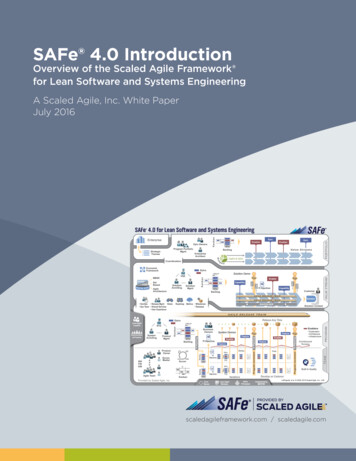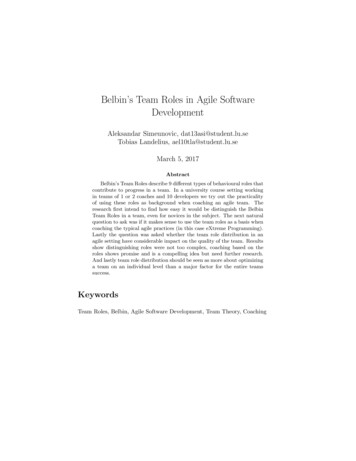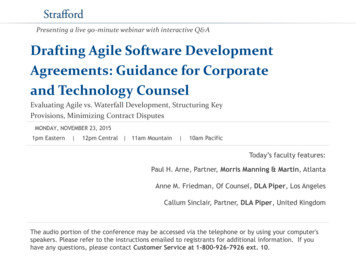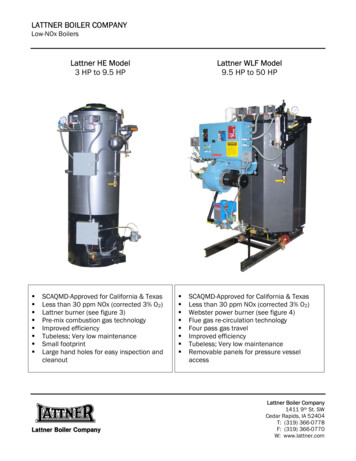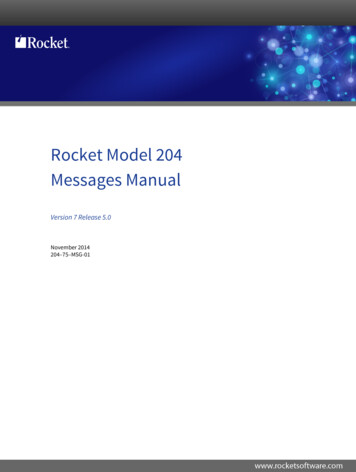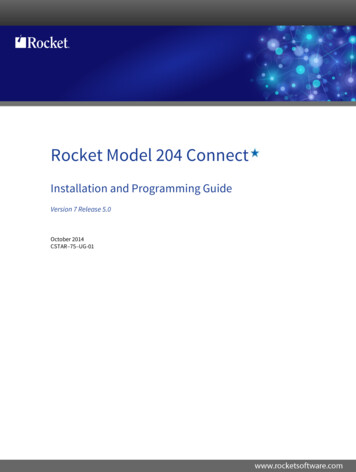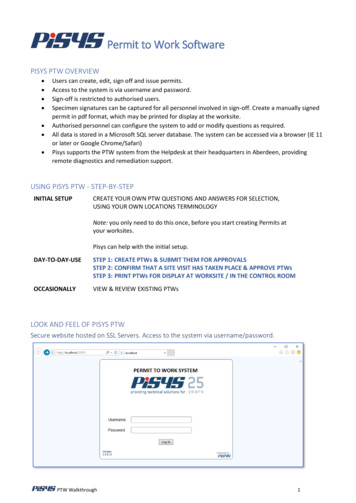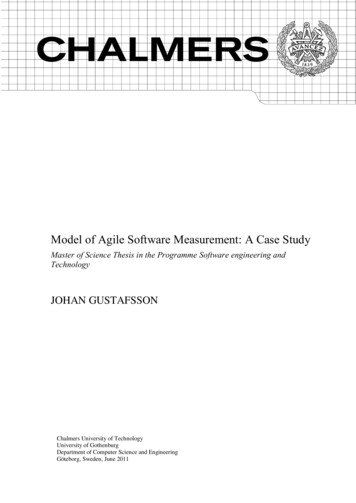
Transcription
Model of Agile Software Measurement: A Case StudyMaster of Science Thesis in the Programme Software engineering andTechnologyJOHAN GUSTAFSSONChalmers University of TechnologyUniversity of GothenburgDepartment of Computer Science and EngineeringGöteborg, Sweden, June 2011
The Author grants to Chalmers University of Technology and University of Gothenburgthe non-exclusive right to publish the Work electronically and in a non-commercialpurpose make it accessible on the Internet.The Author warrants that he/she is the author to the Work, and warrants that the Workdoes not contain text, pictures or other material that violates copyright law.The Author shall, when transferring the rights of the Work to a third party (for example apublisher or a company), acknowledge the third party about this agreement. If the Authorhas signed a copyright agreement with a third party regarding the Work, the Authorwarrants hereby that he/she has obtained any necessary permission from this third party tolet Chalmers University of Technology and University of Gothenburg store the Workelectronically and make it accessible on the Internet.Model of Agile Software Measurement: A Case StudyJOHAN GUSTAFSSON JOHAN GUSTAFSSON, June 2011.Supervisor: ROBERT FELDTChalmers University of TechnologyUniversity of GothenburgDepartment of Computer Science and EngineeringSE-412 96 GöteborgSwedenTelephone 46 (0)31-772 1000Department of Computer Science and EngineeringGöteborg,Sweden
1Model of Agile Software Measurement:A Case StudyJohan GustafssonComputer Science and Engineering.Chalmers University of TechnologyGothenburg, Swedenjohangu@student.chalmers.seAbstract— This master thesis examines what type ofmeasurement should be conducted in agile software development.The paradigm shift that agile methodology offers is in conflictwith traditional measurement approaches and there is a need toclarify if and how measurement can benefit the agile practice. Inthis paper we develop a model that addresses both performanceand process optimization measurement in agile processes. Themodel is evaluated at bwin Games AB, a web game softwarecompany based in Sweden. As a part of the evaluation, an agileinspired measurement framework for implementation of costefficient and flexible metrics is successfully tested. The studyshows that measurement can be beneficial for the agile practice,but that careful consideration to dysfunctional behavior isnecessary.Index Terms— Measurement, KPI, Metrics, Agile softwaredevelopment, Lean software development, Process improvementI. INTRODUCTIONUANTIFIABLE measurement has been described as theQmajorweakness of agile software development, while othersclaim that measurement is an integral part of the agile practice[1]. In today’s software development, traditional life cycleprocesses such as the V model, are still predominant.However, the adaption rate of the agile methodology isincreasing rapidly [2]. In any case, many organizations arelooking for ways to let Key Performance Indicators (KPIs)measure the performance of the agile software development[3].Traditional measurement does not account for the agileculture, and it often leads to undesirable effects [4]. Resultingin a need for a measurement approach that affirms andreinforces the principles that agile is based upon.Besides performance measurement, there is a demandmeasurement in the continuous improvement process [3,These types of metrics have a different character thanKPIs. They diagnose specific problems and are intendedoccasional use.for5].theforWhat companies need is a quick, flexible and cost efficientway to measure.TheAdaptableMeasurementFramework(AMF) particularly focuses on these aspects and is tested inthis research project [6]. The framework brings the principlesof agile into the measurement practice, providing a way todevelop flexible metrics to a low cost and just-in-time.Combining the agile processes with the lean methodology isbecoming increasingly popular in attempts to enhance theagile methods [7]. In the past it has primarily been done byremoving waste. More recently the focus has changed tooptimizing the flow of the value chain. Particularly, the trendin agile development applied in a large scale, is to adopt leansoftware development’s end-to-end perspective [8]. In order toaccount for this trend, it is important to consider the leanprinciples in the recommendations about agile softwaremeasurement.To study the introduction of a measurement system in agilesoftware development, a case study is conducted at bwinGames. bwin Games is a poker network operator in a marketleading position. The company also has its own developmentwhere their next generation of poker products is currentlydeveloped using agile methods. bwin Games is a part of thebwin.party group and has recently received its own profit-andloss responsibility.To facilitate this transformation, they want to introduceagile software measurement. Some KPIs are alreadyimplemented. However, bwin Games are not sure if the KPIsperform its function and measure the right things, nor are thereany measurements in the improvement efforts.The purpose of this thesis is to reveal the best practices ofagile software measurement and apply parts of it at bwinGames. The goal is to understand how performancemeasurement should be conducted in agile softwaredevelopment and how measurement can facilitate the processimprovement effort.
2The intended audience of this paper can be divided intothree categories. The first category is managers and decisionmakers in agile software development. The second category isthose who have an interest in process improvement. The lastcategory is those involved in the coordination of the set ofmeasurements performed in an organization, known asmeasurement systems.The main research question is:What type of performance and process optimizationmeasurement should be performed in agile softwaredevelopment?The report is structured as follows: Section II is a summaryof relevant theories. In Section III the research methodology isdescribed. Section IV presents the results and Section Vdiscusses the result’s validity. Finally, Section VI presents theconclusions.II.BACKGROUNDThis section contains a brief description of relevant theoriesand practices associated with agile measurement. To get acommon understanding of key concepts, some definitions arefirst given.A. DefinitionsHartmann and Dymond [3] propose a division betweenlong-term organizational performance measurement andmeasurement that diagnose locally to achieve processimprovement.Definition: Metric“A measure or a combination of measures for quantitativelyassessing, controlling or improving a process, a product, ateam”[9]Definition: Key Performance Indicator“Quantifiable metrics which reflect the performance of anorganization in achieving its goals and objectives”[10]Definition: Diagnostic“A metric used to diagnose and improve the processes thatproduce business value. What it measures might not have adirect value to the customer.” [11]The general term metric covers all types of measurementstatistics, including both KPIs and diagnostics. KPIs are usedin the long-term performance measurement and measure thevalue produced.Diagnostics are used in the improvement efforts anddiagnose the resources that produce the value. Localinformation needs can be met by the diagnostics and they areintended for occasional use.KPIs and diagnostics are complementary. Theorganization’s performance is revealed by the KPIs. Thediagnostics can find improvement potential in attempts toimprove the KPI’s value. The effectiveness of the diagnosticscan then be judged by the effect they have on the KPIs. [3]In order facilitate correct understanding of different typesof measurement the measurement practice should: Communicate the definition of the different types ofmetrics. Communicate the difference between performance andprocess optimization measurement. Understand how the KPIs and diagnostics complementeach other.Table 1 Best practice checklist for facilitating the correct understanding ofdifferent types of measurement. Based on the sources in this section.B. Industrial Contextbwin Games is in a transition phase and the whole bwingroup has merged with another large online gaming company.The merge has introduced changes and uncertainty in theorganization. In addition, the technology departmentperformed a major reorganization with new management.These factors made the thesis’ decision process slow andambiguous.The thesis’ theoretical validation and strategicrecommendations are mainly done in collaboration with thetechnology department’s process manager. The empiricalwork is conducted at the unit that develops the poker client.The unit follows the Scrum methodology and has three scrumteams composed of programmers, quality analysts and twoscrum masters.C. Agile Software DevelopmentAgile software development has emerged from the recentyears’ changes in the nature of software development [12].The current software market is very volatile and requiresflexible development methods. Traditional pre-defined andplan-driven methods such as the waterfall model [13], oftenfail to meet today’s dynamic market needs. Agile softwaredevelopment recognizes that it is difficult for the customer toknow all the requirements upfront and instead takes anempirical approach.The methods included in the agile software developmentsuch as Scrum [14] and Extreme Programming [15], have acommon basis in the Agile Manifesto and its principles[16].The Agile Manifesto states [16]:―We are uncovering better ways of developing software bydoing it and helping others do it. Through this work we havecome to value: Individuals and interactions over processes and toolsWorking software over comprehensive documentationCustomer collaboration over contract negotiationResponding to change over following a planThat is, while there is value in the items on the right, wevalue the items on the left more.‖The principles behind the Agile Manifesto are [16]: Our highest priority is to satisfy the customerthroughearlyandcontinuousdeliveryof valuable software.
3 Welcome changing requirements, even late indevelopment. Agile processes harness change forthe customer's competitive advantage.Deliver working software frequently, from acouple of weeks to a couple of months, with apreference to the shorter timescale.Business people and developers must worktogether daily throughout the project.Build projects around motivated individuals.Give them the environment and support they need,and trust them to get the job done.The most efficient and effective method ofconveying information to and within a developmentteam is face-to-face conversation.Working software is the primary measure of progress.Agile processes promote sustainable development.The sponsors, developers, and users should be ableto maintain a constant pace indefinitely.Continuous attention to technical excellenceand good design enhances agility.Simplicity the art of maximizing the amountof work not done is essential.The best architectures, requirements, and designsemerge from self-organizing teams.At regular intervals, the team reflects on howto become more effective, then tunes and adjustsits behavior accordingly.The agile methods emphasize rapid feedback and use ofshort iterations. The requirements evolve during the project incollaboration with the customer and facilitated changeprocedures. The teams should be self-organized and consist ofa cross-functional mix. The focus is on delivering customervalue, rather than compliance with a plan.D. ScrumScrum is a management framework for the agile softwaredevelopment and is used at bwin Games. The method is alightweight process and requires only a few sets of rules [17].The intention is to be highly customizable, allowing it to becombined with other methods such as Extreme Programming.which are committed to be delivered at the end of the sprint.To create a stable work environment, no changes to the sprintbacklog are allowed during a sprint.The organization is split into small teams of up to sevenpeople. Each team has its own sprint backlog andresponsibility to see it delivered. The team is composed of across-functional group and is supposed to be self-organizing.The self-organization is driven by the daily scrum meetingswhere each member updates the team on his status and facedobstacles. [17]Besides the team, Scrum has two more roles, scrum masterand product owner. The scrum master is responsible forensuring that the scrum process is followed and takes the roleof a coach, supporting the team in its self-organization. Theproduct owner is accountable for the product backlog. Theproduct backlog must be properly managed, so that theoptimal amount of value is delivered.The most favorable release of the product is done byupdating the product backlog in collaboration with customer,considering the insights gained during the process. Theprocess itself is improved by performing retrospectives aftereach sprint.E. Lean Software DevelopmentAttempts to translate the success of the Toyota ProductionSystem and lean manufacturing have resulted in lean softwaredevelopment. The concept was coined by Mary and TomPoppendieck [19], who identified seven fundamental leanprinciples and suggested how to adapt them to agile softwaredevelopment. The principles are intended to serve as afoundation for a better software development.The lean software development principles are [20]: Fig. 1. The Scrum Process [18]Fig. 1 shows the Scrum process. The requirements areprioritized in the product backlog and are divided into smalldeliverable tasks. The time is partitioned into sprints, which isthe name of the fixed-length iterations. Before the start of asprint, the sprint backlog is filled with tasks selected from theproduct backlog. The sprint backlog then holds the tasks,Optimize the Whole – The focus should be on the entirevalue stream. Sub-optimization will arise if only partsof the system are considered.Eliminate Waste – Everything that is not necessary forvalue creation or directly creates value should beremoved.Build Quality In – Defects should not be found in finalverification. The process should be designed so qualitybecomes an integrated part of it.Learn First – Before making irreversible decisions,learn as much as possible.Deliver Fast – Fast delivery of customer value willprevent requirements from becoming obsolete.Engage Everyone – The people involved in softwaredevelopment are motivated by responsibility,challenge, self-improvement and purpose.Keep Getting Better – Practice continuousimprovement to leverage.Lean software development is heavily focused oneliminating waste. It also emphasizes the importance of havingan end-to-end perspective in order to avoid sub-optimization[12].The view of the waste has changed somewhat in the recentyears. It appears that the metaphor of waste is not as easy to
4adapt to knowledge work [21]. Not everything that does nothave an immediate value to the customer can be removed as itmay be necessary for the implementation of value addingactivities. Instead, it has been proposed to interpret the wasteas cost and divide it into sub categories [11]. By using thelanguage of economy allows lean to be portrayed as moremature and makes it possible to assess whether the removal ofthe waste is beneficial.1) The importance of flowThe elimination of waste is still an important principle, butthe lean software development has changed to be morefocused on the end-to-end flow [22]. The flow of softwaredevelopment is about how the requirements move through thevalue chain. The flow is directly related to the overall goal ofthe software development, i.e. making financial profit. Theprofit is improved by increasing the throughput, requiringshorter lead times.The flow concept is strongly influenced by the generalmanagement philosophy Theory of Constraints (TOC). TOC isabout creating flow by identifying and elevating constraints inthe value chain. It emphasizes that the bottlenecks in the valuechain dictate the overall performance and that resources mustbe focused on the constraint.Alistair Cockburn explains how the requirement’s valuedecay over time [23]. The requirements are based on businessdecisions that on a volatile market easily can become invalid.Therefore, it is important with short lead times. The inventorymanagement contributed to the success of lean manufacturing[22]. In software the inventory is intangible information in theform of requirements, making it easier to neglect themanagement of them. However, every line of code written inan obsolete requirement is waste. The inventory piles upquickly and creates queues. If the inventory is left unattended,the flow will be disturbed and the risk that the requirementsbecome obsolete increases.Reinertsen explains how today’s product developmentorthodoxy in many ways interferes with the flow [22]. Forexample, attempts to remove waste by maximizing thecapacity utilization has a serious risk to lead to a lower overallthroughput. He proposes the following possible solutions onhow to improve the flow of the product development: Improve economic decisions. Quantified economyallows the correct decisions in the development, seeSection II.F.Manage queues. Unmanaged queues results inincreased lead time and prevent effective flow. Thequeues should be controlled and measured, see SectionII.M.1).Reduce batch size. Relates to management of queues.Reduced batch size is proposed to be the most costeffective way to reduce the queues.Apply Work in Process (WIP) constraints. In therelative high variability that characterizes softwaredevelopment WIP constraints is one way to control thelead times, see Section II.E.3).Accelerate feedback. Early transfer of information cancreate significantly economic advantages. By using leading indicators, proactive actions can be taken, seeSection II.F.Manage flows in the presence of variability. Variabilityshould be judged on economic payoff functions and notalways be tried reduced.Decentralize control. In product development problemsand opportunities arise quickly, requiring shortresponse times. With a decentralized control they canbe addressed rapidly.2) Comparison of Lean and AgileKai Petersen's carefully compares of lean and agile softwaredevelopment and concludes that both paradigms agree on thegoals they want to achieve, i.e. the rapid delivery of customervalue [12]. The underlying principles are also shared to a largeextent.The main difference is that lean has more focus on end-toend flow. As lean software development has been developedwith agile in mind it has adopted many agile practices andadded a few of its own, mainly practices regarding the flow.Generally, they are highly overlapping and are able tocomplete each other. Petersen notes in particular that there ispotential for the benefit of the industry to adopt the end-to-endperspective.Because of their complementary nature and common goals,this thesis does not distinguish between agile and lean, interms of recommendations on measurement.3) KanbanKanban is a lean software development method [21]. Itprescribes a small set of rules, which primarily concerns themaintenance of the flow [17]. The original Kanban systemcomes from the manufacturing sector and is a pull systemwhere work is drawn from preceding links in the value chain.The Kanban method applied to software development is builtaround limiting the WIP in various stages of the process. Forexample, the testers signal the developers when their WIPallows more work. In addition, the workflow should bevisualized and the primary metric of success is the lead time.F. The Purpose of Measurement and the Importance ofEconomicsThe fundamental purpose of a measurement system is toprovide feedback. Parameters are measured with the ambitionto increase the chances of achieving a given goal. However,one of the main goals of the measurement syste
Index Terms— Measurement, KPI, Metrics, Agile software development, Lean software development, Process improvement softwa I. principlesINTRODUCTION UANTIFIABLE measurement has been described as the major weakness of agile software development, while others claim that m



